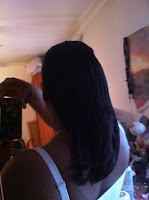| Busting the Black Hair Myths – 5 Myths about Relaxing your Hair |
What's wrong with relaxing your hair? Leading Trichologist, Noon Etienne, examines some of the myths around relaxing hair and offers some advice on how to make relaxing work for you.
Myth No.1: 'I can relax my hair and braid it the next day'
Noon Etienne: No, ladies! The newly processed hair is in a fragile state and you would need to wait at least 4 weeks before you can braid it.
Myth No. 2: 'I can take my hair out of braids or weaves and put a relaxer on it the same day or the next day'
Noon Etienne: This is totally wrong! To get the best results, you need to remove the braids and treat the hair with a reconstructive, moisturizing treatment. Then you should wait for at least one to two weeks before relaxing or retouching the roots.
Myth No. 3: 'I can use a permanent colour on my hair and then put a relaxer on it the next week'.
Noon Etienne: This is totally the wrong way around. The correct sequence is to relax the hair and then you can apply a rinse or semi permanent colour the same day - once you have neutralised and treated the hair.
A permanent colour would not be recommended after having a relaxer process on the same day because the scalp would not be able to with stand the hydrogen peroxide that is found in the permanent colour – in other words, it will sting or burn the scalp!
To get the best results, you need to remove the braids and treat the hair with a reconstructive, moisturizing treatment.
Myth No. 4: 'My hair is totally natural, so I don't need to put any treatment on it before relaxing it'
Noon Etienne: Well, ladies, that is wrong thinking! Even though your hair is natural, you still need to prepare your hair for the chemical process to 'take' correctly.
When the hair is not at its best, the chemical will not relax the hair and may even cause damage to your hair, which will result in breakage in some areas. You should be taking good care of your natural hair with reconstructive, moisturizing treatments every week or two, then your hair will have the strength that it needs for the breakdown process of a relaxer.
Myth No. 5: 'I can put a no-lye relaxer on and leave it for more than one hour!'
Noon Etienne: This is what I call the "Oh, it's not burning yet" attitude –does it sound familiar, ladies? Well, something you need to know about ‘No-Lye relaxers’ is that it is "the biggest Lie in the hairdressing industry"
Of course there are chemicals in the relaxer! There are several types of Lye chemicals - Sodium hydroxide, calcium hydroxide, potassium hydroxide and guanidine. Any of the relaxer kits that you purchase off-the-shelf would contain one of the latter thee ingredients and usually involve mixing a cream and a lotion together for the chemical to be activated. Even though this type of relaxer does not burn, it does not mean "you can leave it on until you feel the burn"! You will end up over-processing your hair, causing it to lose elasticity, moisture and strength.
|













